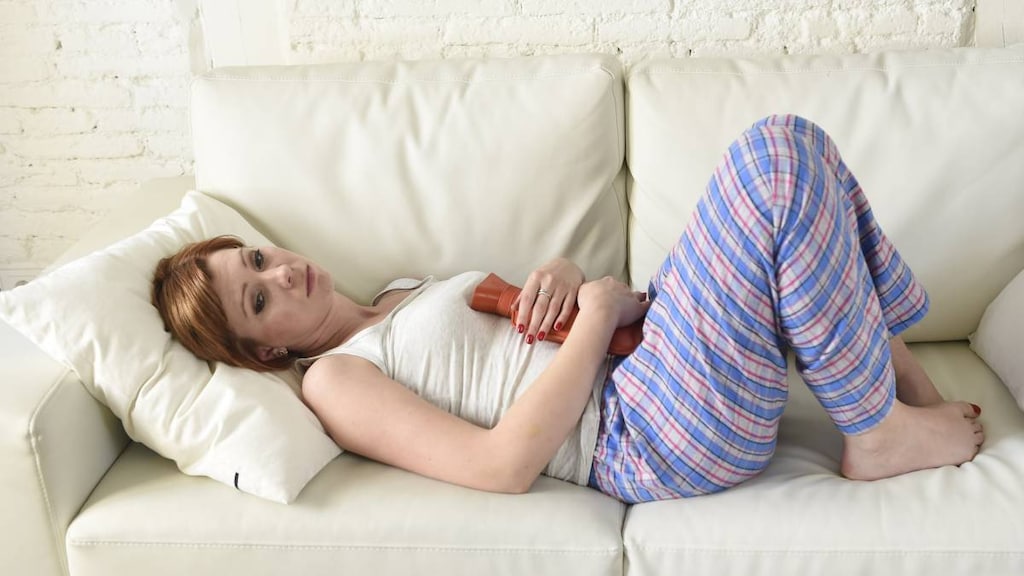What's Causing My Period Pain?

Most women don’t look forward to their monthly menstrual period. For some women, the pain (called dysmenorrhea) is an annoyance or a mild discomfort, but for others, the monthly cycle means severe cramping. It can be hard to know what’s normal and what you should be concerned about. For instance, if you’re experiencing painful period cramps, there could be an underlying condition causing it, such as endometriosis, uterine fibroids or pelvic inflammatory disease, just to name a few.
What causes period pain?
The pain that accompanies menstruation affects more than half of the women who experience monthly periods, according to the American College of Obstetricians and Gynecologists. There are two causes of this pain:
- Primary dysmenorrhea — commonly referred to as menstrual cramps — is caused by natural chemicals, called prostaglandins, in the lining of the uterus. The level of prostaglandins is very high at the start of your period, but as menstruation continues over several days, the uterus sheds its lining and the level of prostaglandins decreases, which usually leads to a decrease in pain. For many women, this type of period pain starts in their teens but decreases as they get older. It can also decrease in women who have given birth.
- Secondary dysmenorrhea, however, results from a problem in the reproductive system. Unlike primary dysmenorrhea, it doesn’t start in the teenage years, instead beginning later in life and often increasing with age. Unlike primary dysmenorrhea, it stems from an underlying medical issue that's causing the pain.
Because of this, it’s important to keep a record of your monthly cycles, noting when you started having painful periods and if they are getting better or worse as you age.
Causes of secondary dysmenorrhea
Some of the conditions that can cause this type of period pain include:
1. Endometriosis
This condition affects more than 10 percent of American women (more than 6 million women) who are between the ages of 15 and 44. For women in their 30s and 40s who are trying to get pregnant, endometriosis can be particularly difficult because the condition can affect fertility, making it harder for a woman to conceive.
Endometriosis develops when tissue that’s similar to what’s found in the uterus starts growing outside the uterus and into the ovaries, fallopian tubes, vagina, cervix and other areas. Painful menstrual cramps are one of the top symptoms, and the pain might get worse — not better — over time. In addition to the pain in the pelvic region, many women experience pain in the lower back, and they also may experience pain during sex. Additionally, some find it painful to go to the bathroom (both bowel movements and urination) during their monthly period. Other signs that you may have this condition include spotting between periods and issues with your digestive system, including diarrhea, constipation or bloating during your monthly cycle.
While there’s no way to prevent endometriosis (you’re more likely to have it if a family member has it — mother, sister, aunt — or if your periods are longer than seven days), you can reduce your chances of getting it by lowering the levels of estrogen in your body. This is often done through hormonal birth control, such as birth control pills with low doses of estrogen. Other ways to decrease the amount of estrogen circulating throughout your body are by exercising regularly and having a low percentage of body fat. Also avoid large quantities of alcohol and caffeine as both can raise estrogen levels.
To check for endometriosis, your doctor will do a thorough pelvic exam (looking for cysts or scarring behind your uterus) and may order an ultrasound or MRI or do a diagnostic laparoscopy.
2. Uterine fibroids
Another culprit for severe period pain can be noncancerous fibroids that appear in the uterus. Some women experience no symptoms from fibroids, while others have heavy bleeding during their periods, back pain, constipation and pressure in their pelvis.
While the fibroids themselves are usually not a serious condition and they don’t usually interfere with pregnancy, they may increase the risk of certain complications in pregnancy. Also, fibroids may result in anemia in some women. To check for fibroids, your doctor would do a pelvic exam and may order an ultrasound, MRI and lab tests. If fibroids are detected, treatment options include medication (which won't eliminate the fibroids but can shrink them) or, in extreme cases, surgery. A hysterectomy, which is surgery to remove the uterus, is currently the only permanent solution for uterine fibroids.
3. Pelvic inflammatory disease
The Centers for Disease Control and Prevention (CDC) notes that pelvic inflammatory disease (PID), a serious condition that can result in fertility issues, is an infection in a woman’s reproductive organs. PID is often caused by a sexually transmitted disease (STD), such as chlamydia or gonorrhea, but can also be caused by infections not related to STDs.
There are no definitive tests to see if you have PID so your doctor will most likely do a thorough medical exam and may run other tests, including a cervical culture, blood and urine tests and possibly an ultrasound. In addition to painful period cramps, other symptoms of PID include:
-
Fever
-
A smell or discharge coming from your vagina
-
Bleeding between periods
-
Burning when you go to the bathroom
-
Pain or bleeding during sex
If diagnosed with PID, your doctor will most likely prescribe antibiotics.
4. Adenomyosis
Painful and heavy periods can result from adenomyosis, which is when the tissue that lines the uterus grows into the wall of the uterus. This tissue, called the endometrial tissue, then thickens, breaks down and bleeds during a woman’s period each month.
Though the condition sometimes has no symptoms, it also may result in heavy periods, pain and cramping. Adenomyosis can also cause an enlarged uterus. The lower abdomen, where the uterus is located, may feel tender or a woman might feel pressure. If a woman is experiencing severe pain and discomfort, her doctor may suggest hormonal treatments or, in some cases, removing the uterus in a hysterectomy.
While the cause of adenomyosis is not known, risk factors include prior C-section, fibroid or uterine surgery and childbirth. This condition is most often found in women in their 40s or 50s, and it often disappears after menopause. While the condition itself is not harmful, adenomyosis can lead to anemia because of the heavy loss of blood and it can get in the way of a healthy lifestyle as you may avoid running, swimming or other activities during your period out of fear you might start having heavy bleeding or feel pain.
5. Cervical stenosis
This condition involves a narrowing in the cervix. Women often do not experience any symptoms, but when symptoms do occur they may include painful periods, no periods or abnormal bleeding. In some cases, the uterus can fill up with blood or pus, though this is rare.
Possible causes of cervical stenosis include:
- menopause
- cancer of the cervix or endometrial lining
- surgery that involves the cervix, such as surgery to treat precancerous changes in the cervical area
- radiation therapy to treat cervical or endometrial cancer.
Treatment can include widening the cervix to help alleviate the symptoms.
The bottom line
For many women, period pain is simply a normal part of your monthly cycle. For others, though, it may also be an indication of something more serious. That makes it important to talk to your doctor about the pain you experience during your monthly cycle. Your doctor can then determine whether such conditions as PID, uterine fibroids and endometriosis can be ruled out or need to be treated.
If your doctor rules out serious conditions, you can treat normal period pain with a variety of techniques, including:
-
Taking over-the-counter medications, such as ibuprofen
-
Using a heating pad or hot water bottle on your stomach and pelvic area
-
Taking a hot bath or a long, hot shower
-
Trying yoga, stretching and moderate exercise to help alleviate the pain of menstrual cramps
Article references
- American College of Obstetricians and Gynecologists, Dysmenorrhea: Painful Periods. https://www.acog.org/Patients/FAQs/Dysmenorrhea-Painful-Periods?IsMobileSet=false
- U.S. Department of Health & Human Services, Endometriosis. https://www.womenshealth.gov/a-z-topics/endometriosis
- Mayo Clinic, Uterine fibroids. https://www.mayoclinic.org/diseases-conditions/uterine-fibroids/symptoms-causes/syc-20354288
- Mayo Clinic, Uterine fibroids/diagnosis. https://www.mayoclinic.org/diseases-conditions/uterine-fibroids/diagnosis-treatment/drc-20354294
- Centers for Disease Control and Prevention, Pelvic Inflammatory Disease (PID) - CDC Fact Sheet. https://www.cdc.gov/std/pid/stdfact-pid.htm
- Mayo Clinic, Pelvic Inflammatory Disease. https://www.mayoclinic.org/diseases-conditions/pelvic-inflammatory-disease/diagnosis-treatment/drc-20352600
- U.S. National Library of Medicine, Period Pain. https://medlineplus.gov/periodpain.html
- Mayo Clinic, Adenomyosis. https://www.mayoclinic.org/diseases-conditions/adenomyosis/symptoms-causes/syc-20369138
- Nationwide Children’s Hospital, Yoga Exercises and Menstrual Cramps. https://www.nationwidechildrens.org/family-resources-education/health-wellness-and-safety-resources/helping-hands/yoga-exercises-and-menstrual-cramps
- Mayo Clinic, Menstrual cramps. https://www.mayoclinic.org/diseases-conditions/menstrual-cramps/symptoms-causes/syc-20374938
- MSD Manuals, Cervical Stenosis. https://www.msdmanuals.com/home/women-s-health-issues/miscellaneous-gynecologic-abnormalities/cervical-stenosis

